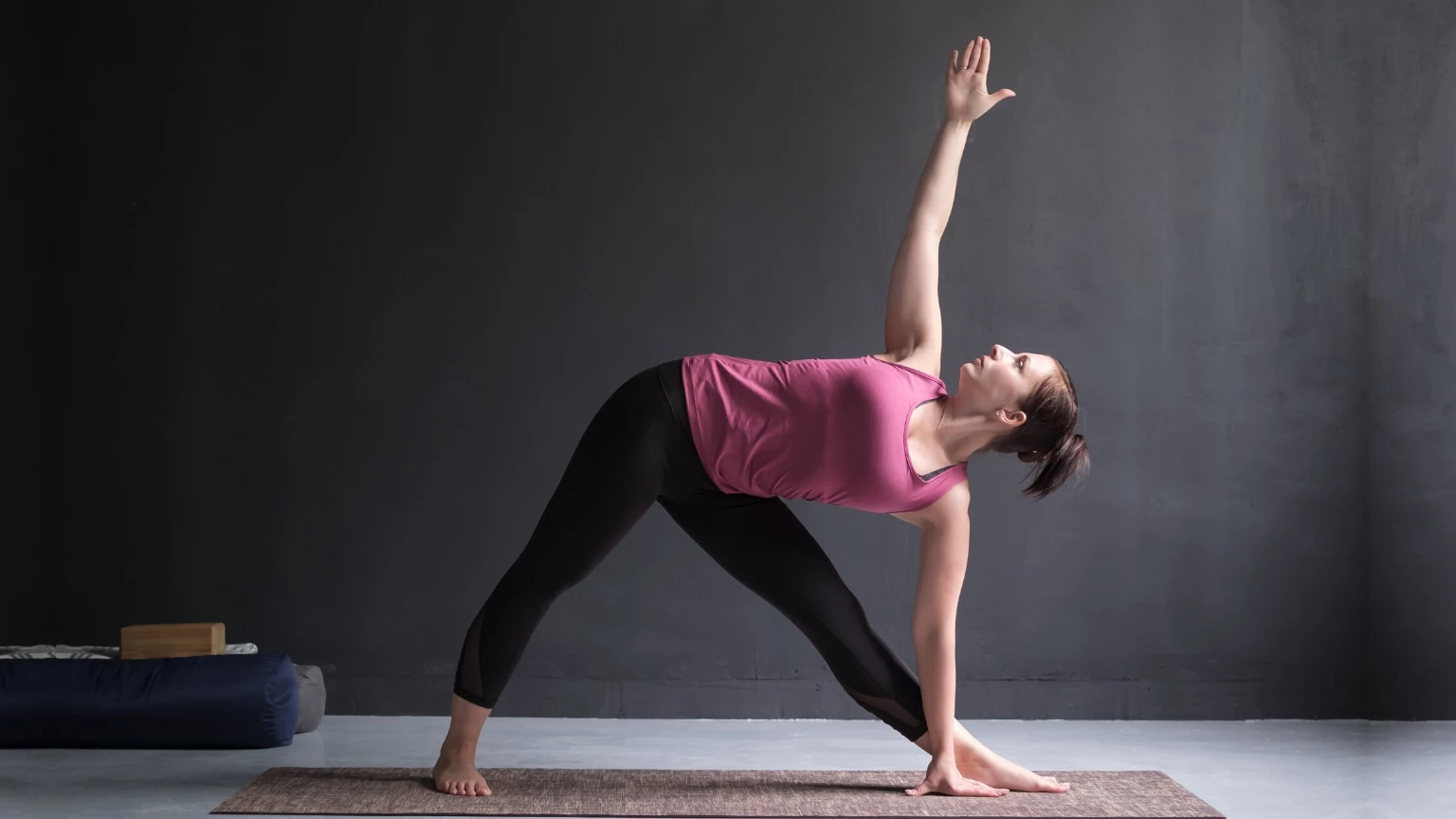Proprioception and Interoception: How Yoga Practice Supports These Essential Skills

Article At A Glance
Did you know that developing interoceptive skills can prevent chronic health issues and create a stronger sense of identity? This article explores the critical senses of proprioception and interoception, highlighting their impact on daily life. Through yoga, we can support interoceptive awareness, leading to improved self-awareness and overall well-being. Read on to learn how.
What’s an example of the many ways proprioception and interoception play out in daily life? I once had a roommate who frequently, inadvertently, injured herself. When I first met her, she didn’t have any eyebrows. She’d burned them off, lighting a big gas stove at a campsite. A few weeks later, she came home with her arm in a cast and sling. She’d fallen off her bike.
A couple of months after that, she was using crutches. She’d twisted her ankle dancing. This went on and on.
She joked about how everyone knew she was an accident-prone klutz. But it wasn’t until many years later, when I started to study the science of movement, that I began to understand that a technical term for “accident-prone klutz” may actually be something more like “proprioceptively challenged.” My roommate had poor proprioception—the ability to feel where her body was in space. And because of that poor proprioception, she often had accidents.

Proprioception is often called “the sixth sense,” the five others include seeing, hearing, smelling, tasting, and touching. This sixth sense helps us to know where we are and what to do with our bodies at any given time.
How Proprioception Works and How Yoga Supports It
Here’s an important thing to understand about proprioception: it’s fast! Fast-firing myelinated (myelin is the fatty sheath around nerves that makes them conduct signals very quickly) mechanoreceptors send messages to your brain, which means they are afferent nerves. Your brain instantly sends messages back to your body to adjust your position and keep you upright regardless of what you are doing.
Let’s say you’re riding on a bumpy bus and although it may be uncomfortable, you still manage to stay upright without a lot of conscious effort. For that, you can thank your proprioceptors. In fact, if you are  sitting here reading this and you’re not falling off your chair, you can thank your proprioceptors.
sitting here reading this and you’re not falling off your chair, you can thank your proprioceptors.
It’s easy to find examples of well-honed-proprioception; watch elite athletes like Megan Rapinoe play soccer! One of the main reasons proprioception is essential (beyond sports skills) is because it keeps you safe. You can walk down the street, stay on a bicycle, balance in Vrksasana (Tree Pose) (below), and, at least sometimes, avoid the emergency room because of this system.
Yoga helps to optimize proprioception because you get to practice all sorts of different ways to stay upright, balanced, and safe in lots of different positions, fast or slow; whatever kind of yoga you do, proprioception benefits.
Proprioception vs. Interoception: Awareness and Yoga’s Benefits
There’s also a seventh sense: interoception. Whereas proprioception is about where your body is in space, interoception is about how your body feels. Do I feel hungry, have to pee, feel hot? When you are tuned in, you make appropriate (and often unconscious) behavioral decisions to return to homeostasis, i.e., you eat lunch, go to the bathroom, and turn on the A/C.
Much of interoception is governed by low-threshold mechanoreceptors that are unmyelinated. The messages are slower and require more time to process. Most interoception happens below the level of consciousness to bring homeostasis to the whole system. However, cultivating interoceptive awareness brings interoception up into the cortex, and this may have numerous health benefits.
Cultivating mindful awareness in your yoga practice can help you develop interoception. The more sensitive we become, the easier it is for us to understand the link between body sensations and skillful responses to those sensations.
A primary benefit is that good interoception helps to dissipate unconscious muscular tension —holding patterns you may not even know that you have! When you start to unravel these patterns, you diminish the effects of stress on your system. And that’s always a good thing. Some researchers have suggested that poor interoception lies at the heart of many chronic diseases. Think about it—if I work too hard, I don’t have time to exercise, I don’t pay attention to my diet, I don’t manage my stress, and then, surprise, I have heart disease!
That’s how ignoring your body’s signals causes you to end up with chronic conditions. Unfortunately, we are often taught in our culture to ignore internal messages from our bodies, even in sports! (Just do it! No pain, no gain!) This attitude may benefit proprioception, but it does not benefit interoception.
Proprioception, Interoception, and Our Sense of Self
Perhaps an even more important benefit of developing interoceptive skills is that good Interoceptive awareness creates a stronger sense of identity. The interoceptors interface with a brain region, the insula—that plays an important role in our sense of self. As you improve interoception, you improve your sense of self. As you improve your sense of self, you get clearer about the meaning and purpose of your life. Think of it this way: if you know how you feel, you know who you are, if you know who you are, you know what to do.
Practicing and Teaching Proprioception and Interoception
How do we practice interoceptive awareness? By slowing down, going inside, and noticing. Slow, mindful movement is an excellent way to develop this system. In Western culture, we focus a lot on sports and movement, so we have many opportunities to develop proprioception. But we have very few places in our culture to develop interoception. A yoga class can provide an excellent opportunity for us to hone this essential skill.
Teach your students the difference between proprioception and interoception. It will help them to understand the unique value of slow, mindful yoga practice and why the time they spend with you is just as important (and maybe more so!) than any other self-care activity they engage in.
(thanks to Susan McCulley for this great graphic.) More of her lovely art here: http://www.susanmcculley.com/)
Also, read...
How Poor Posture Can Lead to Physical and Mental Dis-Ease
Sep 29 – Erik Dalton, Ph.D.
10 Yoga Balance Tips for Developing Proprioception and Maintaining Good Balance
May 31 – Nina Zolotow, RYT 500
Developing Interoception: How to Listen to Your Body Wisdom
Jul 12 – Yasmin Lambat
Related courses
Reprinted with permission from Kristine Kaoverii, Subtle Yoga.

 Committed to the widespread adoption of yoga as a population health strategy, Kristine Kaoverii Weber, MA, C-IAYT, eRYT500, YACEP has been studying yoga and holistic healing for nearly 30 years advocating, speaking, and teaching about yoga since 1995, and training educators since 2003. Her organization, Subtle® Health, LLC, provides holistic, mind-body training, education, and clinical services with the mission of enhancing community health infrastructure. She is the director of the Subtle® Yoga Teacher Training for Behavioral Health Professionals program at MAHEC in Asheville, NC, presents workshops and trainings internationally, and is frequently invited to speak about yoga at health care conferences. After completing her BA and MA at Georgetown University, Kristine trained extensively in many styles of yoga, including Viniyoga, as well as in Asian bodywork therapy and homeopathy.
Committed to the widespread adoption of yoga as a population health strategy, Kristine Kaoverii Weber, MA, C-IAYT, eRYT500, YACEP has been studying yoga and holistic healing for nearly 30 years advocating, speaking, and teaching about yoga since 1995, and training educators since 2003. Her organization, Subtle® Health, LLC, provides holistic, mind-body training, education, and clinical services with the mission of enhancing community health infrastructure. She is the director of the Subtle® Yoga Teacher Training for Behavioral Health Professionals program at MAHEC in Asheville, NC, presents workshops and trainings internationally, and is frequently invited to speak about yoga at health care conferences. After completing her BA and MA at Georgetown University, Kristine trained extensively in many styles of yoga, including Viniyoga, as well as in Asian bodywork therapy and homeopathy.
She is the author of The Complete Self Massage Workbook and has published articles in the International Association of Yoga Therapist’s journal, Yoga Therapy in Practice, and other wellness publications. Her work has been featured in Redbook, BodySense, Women’s World, Natural Health, and Lifetime TV.
Recent articles
In Celebration of Gray-Haired Yoga – Busting the Myth of the Yoga Body
Dec 12 – Charlotte Bell
4 Yoga Poses to Help Ease High Blood Pressure
Dec 08 – Stanley Clark
Categories
Upcoming courses
Reconnecting with Strength: Your Path to Building Greater Inner Resilience
With Arielle Schwartz
Recent articles
Almost there...
Sorry, we couldn't find anything...
Yoga Practice Tips
In Celebration of Gray-Haired Yoga – Busting the Myth of the Yoga Body
I found my first grey hair when I was 22. It wasn’t completely shocking.…
Dec 12 – Charlotte Bell
Yoga Practice Tips
Judith Hanson Lasater on The Art of Teaching Yoga: Making Every Movement an Asana
Judith Hanson Lasater is one of the longest-teaching yoga teachers in the U.S. In…
Dec 09 – By:
Blood Pressure
4 Yoga Poses to Help Ease High Blood Pressure
Approximately 46 percent of Americans have high blood pressure, based on the American Heart…
Dec 08 – Stanley Clark



